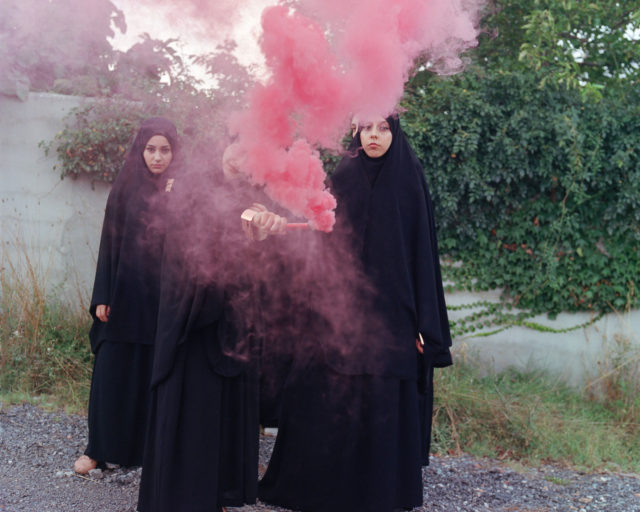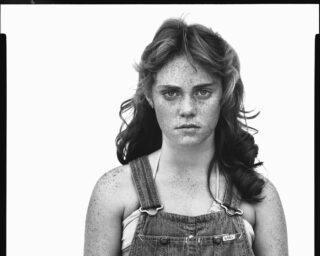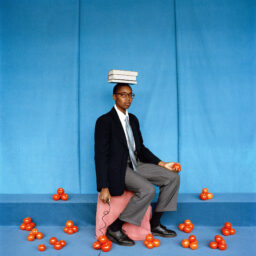Heritage and Home: Photographs of Hickory Nut Gap Farm
Diana C. Stoll reviews Ken Abbott’s new exhibition at the Asheville Art Museum, North Carolina, which focuses on the day-to-day of a prominent local farm and its inhabitants.
Our place here is just a dream, darling, and some day we will be sitting [you] . . . down on a wide porch with a whole stretch of superb mountains out in front. Then dear, you’ll be set down to a table full of country food & after that tucked into bed . . . & you’ll sleep as you haven’t slept in years.
A 1916 letter written by Elizabeth McClure, enticing her cousin Martha to visit her new home, describes a former stagecoach stop known as Sherrill’s Inn located in the hills of western North Carolina. Elizabeth and her husband, Jim, were newlyweds from the North traveling on their honeymoon when they first saw the big house—perched at the top of a slope overlooking acres of fields and farms. North Carolina was not familiar territory for them: Jim McClure was a Yale- and Oxford-educated Presbyterian minister, his young bride a painter who had studied in Europe. Yet they were smitten, and purchased the inn and surrounding land, thus beginning a chapter in the life of Hickory Nut Gap Farm that continues today, a century—and five generations of family—later.
The legacy of a single house can be more enduring than its transitory inhabitants, but in the case of the McClures and their offspring, there has also been a sustained tribal ethos over the decades that seems to have permeated the very walls. The family has been a hub of the community since 1920, when the McClures founded a regional Farmers’ Federation. Later scions of Hickory Nut Gap include the late James Clarke (farmer and congressman in the 1980s) and John Ager (farmer and Democrat in the North Carolina House of Representatives). And yet, whatever local prestige their status might imply, this is a place of groundedness. Everyone tends the land, and in the house, today’s residents live their chaotic lives: beds are sometimes left unmade and sinks are often filled with dishes. It is a place, however, with a perceptible aura of history and lore.
Photographer Ken Abbott first visited the house and farm in 2004 on a trip with his daughter’s preschool, determined to return with his camera. And so he did—again and again, over a decade, discovering new corners with each visit. With his ever-deeper visual understanding of the place and the family, Abbott’s photographs do great justice to the complex life of Hickory Nut Gap Farm, as seen in his book Useful Work (Goosepen Studio & Press, 2015—with essays on the family’s story by historian Rob Neufeld) and in the exhibition Heritage and Home, currently on view at the Asheville Art Museum.
Abbott’s background has equipped him well for this project: as an undergraduate at Colorado College in the late 1970s, he studied with Frank Gohlke, and after attending Yale’s MFA program in photography, Abbott returned to his native Colorado, where he found an advisor and friend in Robert Adams. Abbott’s mentors seem to have provided him both inspirations as well as aesthetic and emotional stances against which to press. Like Gohlke and Adams—and like Eugène Atget, Lewis Baltz, Walker Evans, and many others—Abbott deftly straddles a line in his work between document and art. Unlike them, he rarely adopts a visual tone of dispassion, and instead revels (and allows us to revel) in the sheer handsomeness of colors, forms, depths, and nostalgic narratives. The elements the McClures surely fell in love with a century ago are palpable in Abbott’s images.
Abbott investigates the near and the far: from the weathered, wooden exterior walls of a smokehouse to the voluptuous gray swells of the distant mountains. Day-to-day implements and chores—the “useful work” of Hickory Nut Gap Farm—are shown to be embodiments of beauty: a wood-burning stove in the kitchen (undoubtedly a nod to Evans); rag rugs hung on a fence to dry; a triangular barn behind a white-picket proscenium. One senses some obligation in his images of visiting children—they are almost jarringly of the present—whereas other portraits, of farmworkers and family members, seem absolved from debt to any particular era. A young farmer presses a shovel into a row of carrots with a purposeful gesture; another lifts a young lamb, checking its belly with all the heedfulness of a new father. This is not for show; it is how farms have operated for millennia.
The meaning in these photographs derives mainly from the layered histories they reveal. In one image we encounter an antique highboy dresser—a venerable old Queen Anne specimen, so tall it nearly touches the ceiling of a book-lined room. Its drawers are all ajar, exploding with clothes, a captain’s hat slung on one side and a keffiyeh on the other; and perched on top is what looks like a purple-velvet dog bed. Here the old and the new coexist, sometimes humorously, in jumbled harmony.
One of the most lyrical photographs in Abbott’s collection is of a silver pitcher sitting on a blue Formica kitchen countertop. The pitcher, its curves reflecting white light from the window and the blue of the counter, sits by a glass of water, a Mason jar, a dish drainer stacked with pots, and a plastic bottle of dish soap. Abbott informs us that this pitcher, which once belonged to Elizabeth McClure, is still used by the family every day to bring water from the springhouse to their table. It is, he writes, “an aesthetic connection for the family to Elizabeth, but also . . . a connection to the place.” Like many of the images in this series, the photograph captures the intimate, living spirit of this home, where the now collides so propitiously with the then.
Heritage and Home: Photographs of Hickory Nut Gap Farm is on view at the Asheville Art Museum, North Carolina, July 18–October 11, 2015.
Diana C. Stoll is a writer and editor based in western North Carolina.


























